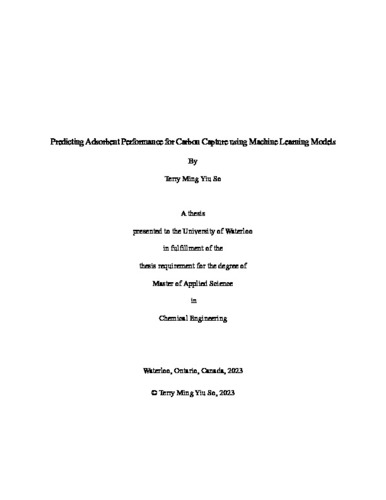| dc.contributor.author | So, Terry Ming Yiu | |
| dc.date.accessioned | 2023-12-22 20:22:19 (GMT) | |
| dc.date.available | 2023-12-22 20:22:19 (GMT) | |
| dc.date.issued | 2023-12-22 | |
| dc.date.submitted | 2023-12-08 | |
| dc.identifier.uri | http://hdl.handle.net/10012/20199 | |
| dc.description.abstract | Carbon capture is a promising way to slow down climate change from anthropogenic sources. One of the carbon capture technologies that is being actively researched is adsorption. Given the increasing amount of literature that present novel ideas, being able to predict this information based on adsorbent textural properties is desirable. In this thesis, machine learning is used to construct a model to estimate adsorbent performance.
Currently, many groups are researching novel adsorbents simultaneously. While beneficial for development, the organization of data varies between papers, as preparation and testing conditions affect the adsorbent performance. Determining the adsorbent data representative of the adsorbent is a difficult challenge, given the presentation and availability are varied. Thus, a section of the thesis focuses on determining which parameters are able to represent the adsorbents while being commonly reported in the literature. A general review of the textural properties is presented. The adsorbent types are also described in the literature review to capture the differences present in adsorbents.
Models trained using five different machine learning methods are examined in detail. The models use the adsorbent’s textural properties along with the testing conditions to estimate the adsorption capacity for an adsorbent. Additionally, the isotherm parameters are also targeted in additional models. Comparisons are performed between the directly predicted capacity and the capacity estimated from the modelled isotherm parameters; this is performed over the different machine learning methods used. A section of the thesis is dedicated to examining a sample adsorbent in more detail based on the ML model. An Aspen Adsorption bed model is used to investigate the effects of the differences between the model. The models exhibit limited performance in the general setting, despite the good training performance. The performance is approximate at a high level, but the requirements to capture the relationship between the adsorbents and its performance is not readily available. | en |
| dc.language.iso | en | en |
| dc.publisher | University of Waterloo | en |
| dc.relation.uri | https://borealisdata.ca/dataset.xhtml?persistentId=doi:10.5683/SP3/T1IHAR&version=DRAFT | en |
| dc.subject | carbon capture | en |
| dc.subject | adsorption | en |
| dc.subject | adsorbent | en |
| dc.subject | machine learning | en |
| dc.title | Predicting Adsorbent Performance for Carbon Capture using Machine Learning Models | en |
| dc.type | Master Thesis | en |
| dc.pending | false | |
| uws-etd.degree.department | Chemical Engineering | en |
| uws-etd.degree.discipline | Chemical Engineering | en |
| uws-etd.degree.grantor | University of Waterloo | en |
| uws-etd.degree | Master of Applied Science | en |
| uws-etd.embargo.terms | 0 | en |
| uws.contributor.advisor | Elkamel, Ali | |
| uws.contributor.affiliation1 | Faculty of Engineering | en |
| uws.published.city | Waterloo | en |
| uws.published.country | Canada | en |
| uws.published.province | Ontario | en |
| uws.typeOfResource | Text | en |
| uws.peerReviewStatus | Unreviewed | en |
| uws.scholarLevel | Graduate | en |

